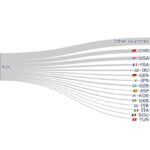Have you ever gazed up at the night sky and wondered why planets appear as perfect globes? From our Earth to distant Jupiter, planets share a remarkably round shape. The simple answer lies in a fundamental force of nature: gravity. A planet’s own gravity is the sculptor, pulling everything towards the center and forging these celestial bodies into spheres.
The Universal Roundness of Planets
Our solar system is home to eight diverse planets. They vary dramatically in size, composition, and distance from the sun. Some, like Mars and Earth, are rocky and relatively small. Others, such as Jupiter and Saturn, are colossal gas giants. Despite these differences, a common characteristic unites them: their spherical shape. Why this consistent roundness? Why don’t we see planets shaped like cubes, pyramids, or flat discs?
Planets begin their lives as swirling clouds of gas and dust in space. Over millions of years, through a process called accretion, particles start to collide and stick together. As these clumps grow larger, their gravitational pull increases. Gravity is the force that binds matter together in the cosmos. Once a forming planet amasses enough mass, its gravity becomes the dominant force shaping its destiny. This growing gravitational influence allows the protoplanet to attract even more space debris, clearing its orbital path around its star.
Imagine gravity as countless threads pulling inward from every point on a planet’s surface towards its center. This gravitational pull acts equally in all directions. Think of it like the spokes of a bicycle wheel, all converging at the central hub. This uniform, inward pull compels the planet’s material to collapse into the most stable and efficient shape possible: a sphere. A sphere is a three-dimensional circle, where every point on the surface is equidistant from the center.
Not Perfectly Round: The Equatorial Bulge
While planets are generally round, it’s important to note that “round” doesn’t always mean “perfectly spherical.” Mercury and Venus come closest to being perfect spheres, resembling smooth marbles. However, some planets exhibit a slight bulge around their middles.
Saturn and Jupiter are prime examples of this phenomenon. These gas giants are noticeably wider at their equator than they are from pole to pole. This bulge, known as an equatorial bulge, is a consequence of their rapid rotation. As a planet spins, points at its equator travel faster than points closer to its poles. This is akin to how the outer edge of a spinning wheel moves faster than the area near its axle.
Consider the equator as a line circling the planet halfway between the north and south poles. Gravity is constantly pulling material inwards. However, the centrifugal force generated by the planet’s spin acts outwards, particularly at the equator. Imagine mud flying off a spinning tire – that’s a simplified analogy of the outward force. In fast-spinning, massive planets like Saturn and Jupiter, this outward force is significant enough to cause a bulge at the equator, despite gravity’s strong inward pull. This results in them being wider at the equator, making them oblate spheroids rather than perfect spheres.
Saturn exhibits the most pronounced equatorial bulge in our solar system. Its equatorial diameter is about 10.7% larger than its polar diameter. Jupiter’s bulge is also significant, with an equatorial diameter roughly 6.9% greater than its polar diameter.
Instead of being perfectly round like marbles, these planets are more like basketballs that have been slightly squashed.
Roundness of Other Planets
Earth and Mars, being smaller and rotating more slowly than the gas giants, are closer to perfect spheres. Earth’s equatorial bulge is only about 0.3% of its polar diameter, and Mars’s is around 0.6%. These small percentages indicate that they are remarkably round.
Uranus and Neptune fall somewhere in between. Uranus has an equatorial bulge of approximately 2.3%, while Neptune’s is about 1.7%. They are not perfectly spherical, but they are still considerably round.
Experiencing the Forces of Spin
Want to get a sense of the forces at play on a spinning planet? You can experience it yourself! Ensure you have a clear, safe space around you. Then, either standing or in a swivel chair, spin around in circles. Start with your arms close to your body, then extend them outwards. Move your arms in and out as you spin and feel the difference. When your arms are outstretched, your hands have to travel a greater distance than your shoulders in the same amount of time, meaning they move faster and experience a greater outward force. This simple experiment gives you a small glimpse into the forces that shape planets and cause equatorial bulges in rapidly rotating worlds.
In conclusion, the round shape of planets is primarily attributed to the relentless force of gravity, pulling equally from all directions to create spheres. While factors like rotation can cause slight deviations from perfect sphericity, particularly in fast-spinning gas giants, the overarching principle remains: gravity is the fundamental sculptor of planetary roundness.
